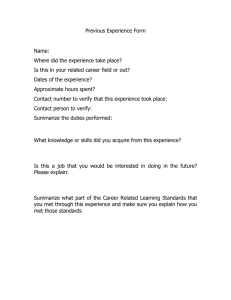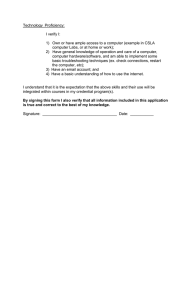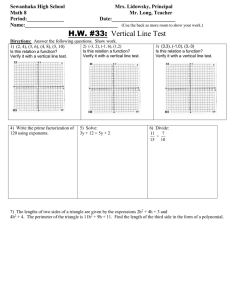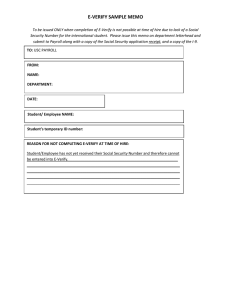Prototype Test Plan Outline
advertisement
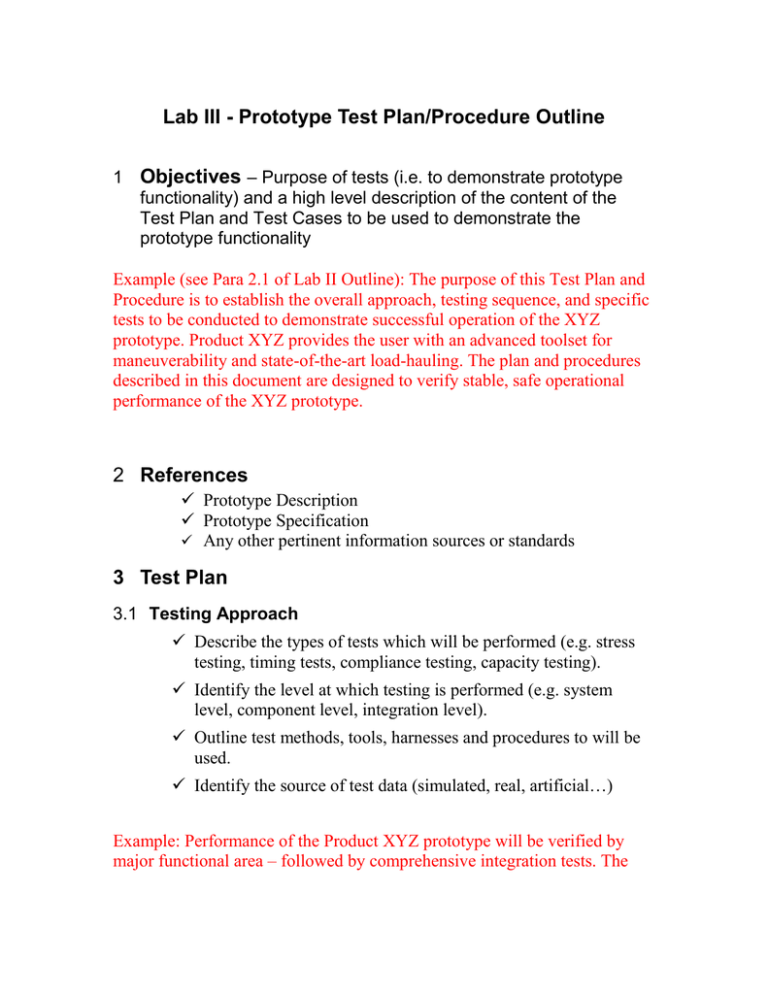
Lab III - Prototype Test Plan/Procedure Outline 1 Objectives – Purpose of tests (i.e. to demonstrate prototype functionality) and a high level description of the content of the Test Plan and Test Cases to be used to demonstrate the prototype functionality Example (see Para 2.1 of Lab II Outline): The purpose of this Test Plan and Procedure is to establish the overall approach, testing sequence, and specific tests to be conducted to demonstrate successful operation of the XYZ prototype. Product XYZ provides the user with an advanced toolset for maneuverability and state-of-the-art load-hauling. The plan and procedures described in this document are designed to verify stable, safe operational performance of the XYZ prototype. 2 References Prototype Description Prototype Specification Any other pertinent information sources or standards 3 Test Plan 3.1 Testing Approach Describe the types of tests which will be performed (e.g. stress testing, timing tests, compliance testing, capacity testing). Identify the level at which testing is performed (e.g. system level, component level, integration level). Outline test methods, tools, harnesses and procedures to will be used. Identify the source of test data (simulated, real, artificial…) Example: Performance of the Product XYZ prototype will be verified by major functional area – followed by comprehensive integration tests. The functional areas are illustrated in figure xx. Performance will be verified through the following types of tests: 1. User interface tests to verify that cockpit controls, layout, and command and data entry sequences are intuitive, repeatable, and meet operational tolerances. 2. Mechanical performance tests to verify power control and transfer, maneuverability, and stability within the limits of the specified performance boundaries. 3. External interface tests to verify proper processing and distribution of post-combustion waste products. Initial tests will be conducted to verify performance in each of the abovelisted performance areas under controlled parameters. Upon successful completion of these tests, “free-play” tests will be conducted to verify the integrity of cooperating functions in a non-rigid test environment. Cockpit Exhaust Distribution Element (simulated) (simulated) Rubber-band Propulsion System Fixed Position Wheels Variable Position Wheels Figure xx – XYZ Prototype Functional Diagram All tests will be conducted in an open-field environment under dry conditions. Verification of user interface tests will be completed through observation. Mechanical tests will require load simulation and power monitoring equipment. External interface tests will be completed by monitoring and recording carbon monoxide flow during all mechanical test events. 3.2 Identification of Tests - high level list of individual tests and objective of each test – this can be in bullet or tabular form (Note: A Test Case will be prepared for each test identified here) Example: The following tests will be performed: Category ID 1 2 3 Description User Interface Mechanical Performance – Static Operations Mechanical Performance Controlled Operations Test Case Description 1.1 Physical Layout 1.2 Steering 1.3 Power Monitoring 2.1 Starting 2.2 Power Management 2.3 Motion Management 2.4 Shut Down 3.1 Straight-line maneuvers Objective Verify Location of Steering, Power Control, Braking meets standards Demonstrate mechanical interface between steering wheel and front wheel assembly Confirm function of power monitoring indicators Confirm starting sequence and functionality Verify power can be increased/decreased on command Verify forward/reverse mechanical transfer actions Verify shut-down sequence and functionality Verify steering, power control, stopping performance during straight-line operations << (Note to Students: Concept is to provide traceability from Test Cases to Spec and from Spec to Test Cases. Overall Test Categories help organizing, resource planning, scheduling, etc. Test Cases break overall testing into discrete, self-contained events) 3.3 Test Schedule- a schedule indicating the sequence of tests and time allotted for each including preparation Example: Tests will be completed within a 12-hour period in accordance with the following schedule: Start Time Duration Test Test Dependencies (hours:min) (Minutes) Objective Event 0 30 User 1.1, Dry weather Interface 1.2 0:30 Comments Position product XYZ in open field 15 Static Ops 2.1 1.1, 1.2 - Starting 0:45 75 Static Ops 2.2, 2.1 – Motion 2.3 Control 2:00 15 Static Ops 2.4 2.1 – Shut Down 2:15 90 Controlled 3.1 1.2, 2.1, 2.2, Ops – 2.3 Straight Line <<example only – all test events should be scheduled>> 3.4 Fault Reporting and Data Recording - a description of how test results will be recorded, including any specific values to record and how faults or test failures will be documented 3.5 Resource Requirements – identify resources required to set up and execute the test. These may include: hardware requirements (e.g. hardware items, interfacing equipment, firmware items) software requirements (e.g. operating systems, compilers, test drivers, test data generators). documentation requirements (e.g. test documentation). people requirements (e.g. Department X employees, customer employees). test data requirements any other requirements (e.g. special equipment). 3.6 Test Environment - describe the plans for setting up the test environment. 3.7 Test Responsibilities - Describe responsibilities of each member of the test team 4 Test Procedures – describe each planned test, the procedures required to execute the test, expected results, etc. in the form of Test Cases 4.1 Test Case Name and Identifier – a unique reference number and name assigned to the test case The following information should be included for each Test Case. It can be presented in bullet/subparagraph form or in tabular form. Additional information can be included as appropriate: Requirements Traceability - cross reference(s)to applicable requirements as identified in the Requirements Specification. Description of Test - a brief overview of the test. Test Initialization - preset hardware/software conditions, preset data values or database setup Test Inputs - describe test inputs Test Procedure - detailed steps used to perform the test. Expected Result - the expected outcome of the test or a description of the type of result the tester should verify Special Instructions - anything that the tester needs to be aware of when running the test e.g. another Test Case must be run first, the test produces a large quantity of printout, specific data recording instructions, etc. Example: (Note – this can be implemented in paragraph form as below – or table form. Concept is to provide traceability from Test Cases to Spec and from Spec to Test Cases. Overall Test Categories) 4.1.1 – User Interface Tests Test Case 1.1 - Physical Layout Specification Reference: 3.1.1 User Command Entry and Status Display Test Description: This test will verify that the physical layout of the cockpit and all controls is in accordance with recognized standards for placement, visibility, and accessibility. Initialization: Steering wheel centered Motion control in neutral position Emergency brake set Seat adjusted to forward-most position Test Inputs: None Test Procedure: 1. Place Test Subject in seat 2. Adjust to distance from steering wheel equal to full extent of Test Subject arms 3. Measure/record distance to pedals, motion control, starting assembly, and each gauge and control knob. 4. Verify Test Subject can reach all controls without leaving seat. Expected Test Results: 1. Test Subject can fit in seat in forward-most position (Pass/Fail) 2. Subject can move seat to full arm extent from steering wheel (Pass/Fail) 3. Distances within specification parameters (Measurements Recorded Pass/Fail each) 4. All controls accessible from seated position (list - Pass/Fail each) Special Instructions: 1. Test Subject must meet parameters of average males in continental US from the 25-38 year age group. 2. Tests to be conducted in dry, open field environment during daylight hours 3. Measurements must be taken with laser measuring tool and recorded in metric units. 5 Traceability to Requirements – provide traceability matrix summarizing requirements/test traceability
